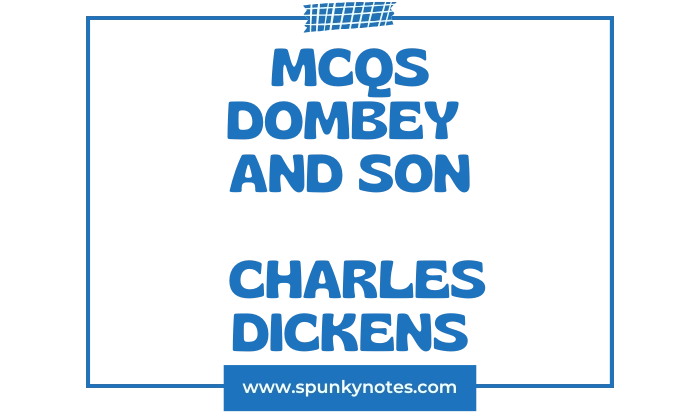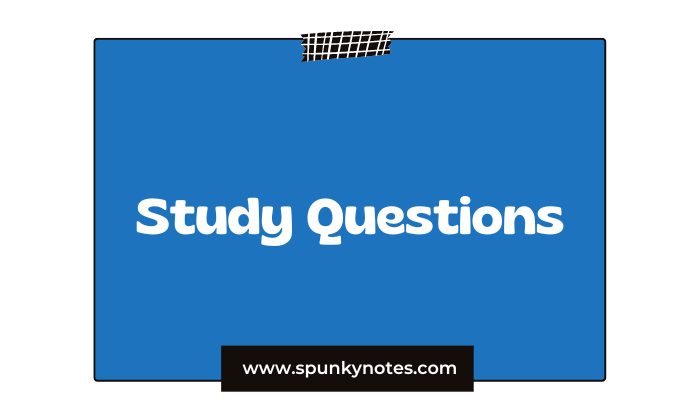
Dombey and Son MCQs
1. Mr. Dombey slightly bent his brows when the nurse mentioned whom?
A. Major Bagstock
B. Miss Tox
C. Miss Florence
D. Doctor Peps
2. Louisa (Mrs. Chick) said it was ridiculous how much the baby resembled whom?
A. Himself
B. George or Frederick
C. A perfect Dombey
D. Mr. Chick
3. Mrs. Chick believed that only an effort on Fanny’s part was wanting to resolve what situation?
A. Her illness
B. Her emotional state
C. Her financial state
D. Her lack of appetite
4. What sound seemed to be running a fierce and furious race in the ensuing pause by the bedside?
A. The grandfather clock
B. The watches of Mr. Dombey and Doctor Peps
C. The wind outside
D. Florence’s weeping
5. What was the family name of the apple-faced family, including Polly?
A. Gills
B. Toodle
C. Blockitt
D. Nipper
6. Mr. Dombey sternly asserted that what relationship existed between his son and the Toodle children?
A. Close connection
B. None
C. A slight one
D. A distant cousinship
7. Mr. Dombey stipulated that Polly Toodle must always be known by what ordinary and convenient name while in his house?
A. Blockitt
B. Jemima
C. Richards
D. Susan
8. Who was the young Spitfire, whose real name was Susan Nipper?
A. Mrs. Chick’s maid
B. Miss Tox’s maid
C. Florence’s maid
D. Mrs. Dombey’s maid
9. What was the name of the old instrument-maker introduced in Chapter 4?
A. Captain Cuttle
B. Walter Gay
C. Solomon Gills
D. John Bunsby
10. What item outside the nautical instrument-makers’ shops was eternally employed in taking observations of hackney carriages?
A. A brass sextant
B. A little timber midshipman
C. An anchor
D. A spy-glass
11. Captain Cuttle believed his Uncle Sol was choked full of what?
A. Wine
B. Science
C. Humour
D. Guile
12. Susan Nipper referred to Miss Tox and Mrs. Chick as the two what?
A. Sirens
B. Beauties
C. Griffins
D. Witches
13. During the christening ceremony, Miss Tox kept her Prayer-book open at which service?
A. The Burial Service
B. The Gunpowder Plot
C. The Matrimony Service
D. The Coronation Service
14. Mr. Dombey nominated Polly Toodle’s eldest son (Biler) to which establishment?
A. Christ’s Hospital
B. The Charitable Grinders
C. Eton College
D. Doctor Blimber’s school
15. Where did Good Mrs. Brown compel Florence to sit after abducting her?
A. Upon a stool
B. Upon the rags
C. Upon the floor
D. Upon the bed
16. When Walter found Florence, he proposed taking her to whose house?
A. Mr. Dombey’s
B. Captain Cuttle’s
C. Uncle Sol’s
D. Mrs. Chick’s
17. Major Bagstock’s walking-stick flourish was meant to indicate about himself that he was what?
A. Kind
B. Weak
C. Sly
D. Rich
18. What question did little Paul abruptly ask Mr. Dombey regarding the subject of his father’s thoughts?
A. What is happiness?
B. What is Dombey and Son?
C. What is destiny?
D. What’s money?
19. What did Paul wonder, if money was a good thing that could do anything?
A. Why it didn’t save his Mama
B. Why it couldn’t buy him happiness
C. Why it made his Papa busy
D. Why it didn’t fix his legs
20. What was the secret of Mrs. Pipchin’s “management” of children?
A. Kindness and rewards
B. Giving them what they disliked
C. Strict adherence to rules
D. Corporal punishment
21. Paul said that if Florence were in India, he would do what?
A. Miss her
B. Wait for her
C. Die
D. Write letters
22. Who was Mrs. MacStinger?
A. Captain Cuttle’s landlady
B. A friend of Mrs. Chick
C. A teacher at Dr. Blimber’s
D. Mr. Dombey’s housekeeper
23. What was the amount of Sol Gills’s debt that threatened his shop?
A. Fifty pounds, odd
B. One hundred pounds, odd
C. Two hundred pounds, odd
D. Three hundred and seventy, odd
24. What was Major Bagstock’s complexion compared to?
A. A Stilton cheese
B. A raw piece of beef
C. A ripe tomato
D. A piece of red marble
25. Walter Gay came to Mr. Dombey to offer what as security for his uncle’s debt?
A. His salary and the stock of Sol Gills
B. His life and servitude
C. Captain Cuttle’s annuity
D. His inheritance
26. Doctor Blimber’s establishment was compared to a great what, with a forcing apparatus incessantly at work?
A. Glass factory
B. Hot-house
C. Steam engine
D. Laboratory
27. Young Toots’s initial remark to Paul in the deepest possible voice was what?
A. Welcome to Parnassus
B. How are you?
C. What is money?
D. Study hard
28. What was the boy’s name who sat in stony stupefaction since breakfast time?
A. Tozer
B. Johnson
C. Briggs
D. Bitherstone
29. Mr. Dombey’s head clerk, Mr. Carker, was known for his wide and frequent what?
A. Cough
B. Scowl
C. Show of his teeth
D. Bow
30. The young man Carker suggested sending to the Barbados agency was Walter Gay, aboard which ship?
A. The Cautious Clara
B. The Son and Heir
C. The Royal Exchange
D. The Toodle’s Joy
31. What did the workman outside the school whisper to the footman that Paul overheard?
A. Clever boy
B. Old-fashioned
C. Delicate
D. Dreamer
32. When Paul was sick, who was the doctor Paul’s interest centered on, because he had been with his Mama when she died?
A. Mr. Feeder
B. Mr. Dombey
C. Mrs. Wickam
D. Sir Parker Peps
33. What did the statuary point out to Mr. Dombey when correcting the inscription for Paul’s tomb?
A. “Beloved and only child”
B. “Precious little one”
C. “Son and Heir”
D. “A perfect Dombey”
34. What type of coat was the working man wearing who ducked his head to Mr. Dombey at the railway platform?
A. A blue Grinder’s coat
B. A cindery coat (Toodle)
C. A sailor’s coat
D. A new coat
35. What was the name of Mrs. Skewton’s daughter?
A. Cleopatra
B. Louisa
C. Edith Granger
D. Lucretia Tox
36. Major Bagstock referred to Mrs. Skewton as what classical figure?
A. Venus
B. Helen
C. Cleopatra
D. Diana
37. Carker gave Rob the Grinder instructions to find out who came to see whom?
A. Miss Tox
B. Sol Gills (Walter’s Uncle)
C. Major Bagstock
D. Mr. Dombey
38. What was the secret signal Captain Cuttle taught Rob the Grinder to whistle?
A. Rule Britannia
B. Oh cheerily, cheerily!
C. The Midshipman’s Lament
D. Hearts of Oak
39. Where did Sol Gills, in his letter to Cuttle, say he had gone in search of Walter?
A. To the East Indies
B. To the West Indies
C. To Australia
D. To China
40. How did Carker say that Mr. Dombey viewed his wife (Edith) regarding her position and reputation?
A. As a dependant
B. As partaking of both wife and dependant
C. As an equal partner
D. As a necessary ornament
41. When Edith prevented Mr. Dombey from leaving, she said that in the dark end they were tending to, they would involve whom besides themselves?
A. Major Bagstock
B. The family name
C. Others
D. Their fortune
42. Who did Mr. Carker the Manager suggest that Edith was greatly interested in, which was a point of influence over her?
A. Mr. Dombey
B. Florence
C. Mrs. Skewton
D. Cousin Feenix
43. The old woman who watched Rob the Grinder writing the name of the place was who?
A. Mrs. MacStinger
B. Mrs. Skewton
C. Mrs. Brown
D. Mrs. Perch
44. What foreign city did Rob the Grinder chalk on the table as the meeting place for Carker and Edith?
A. Paris
B. Brussels
C. Dijon
D. Sicily
45. Who was the gentleman who visited Harriet and John Carker late at night to discuss James Carker’s actions?
A. Mr. Carker
B. Mr. Morfin
C. Mr. Dombey
D. Major Bagstock
46. What was the word that Alice said was helping to harden her, based on things she had heard?
A. Revenge
B. Duty
C. Wrongdoing
D. Suffering
47. What type of man was Mr. Dombey resolved to be, according to Mr. Morfin, in paying debts to the last farthing?
A. A fool
B. A generous man
C. A gentleman of high honour and integrity
D. A wealthy man
48. What did the sight of the darkening mark upon Edith’s bosom make her afraid of?
A. Mr. Dombey
B. Being wicked
C. Mrs. Skewton
D. Her shadow
49. What was the name of the Reverend who officiated at Captain Bunsby’s wedding?
A. Reverend Feeder
B. Reverend Melchisedech Howler
C. Reverend Gills
D. Reverend Cuttle
50. What was the final toast, proposed by Mr. Dombey and agreed upon by the party, using the special wine?
A. To Florence
B. To Walter
C. To the Last Bottle of Old Madeira
D. To Dombey and Son
Brief Overview
Dombey and Son is about pride, family, and the need for love. Mr. Paul Dombey is a wealthy and proud businessman who dreams of his son growing up to take over the family firm.
He cares more about his son, little Paul, than his daughter, Florence, because he sees the boy as a future partner. Florence loves her father deeply, but he gives her little attention or kindness.
When little Paul dies at a young age, Mr. Dombey’s dreams are crushed. Still, he refuses to accept comfort from Florence and becomes even colder and more distant.
He later marries Edith, a proud but unhappy woman who cannot love him because of his selfish nature. Their marriage is loveless and ends in ruin, leading Dombey to lose both family and business.
Broken and lonely, Mr. Dombey finally realizes Florence’s true love for him. In the end, Florence cares for her father, and he slowly learns the value of affection over pride.

